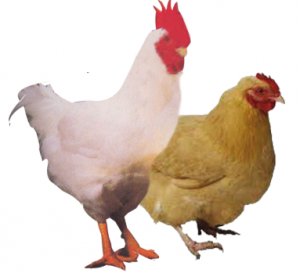BROILER PRODUCTION
Broilers are considered important because they serve as a source of animal protein by providing meat due to their fast growth rate.
They are a reliable source of income to small scale farmers since the starting capital requirement is not very high and the returns are faster i.e. within 6 weeks.
Empire Feed (K) Ltd manufactures of Empire Feeds ® have carefully formulated broiler feeds to achieve best quality and maximum weight gain from the least amount of broiler feed in the shortest time possible.
Broiler Management
Housing
The major housing requirement is the stocking density which is influenced by the size of the birds. Broilers can be raised in one house up to the market age or can be started in a separate brooder house. Stocking rate is set at 1 sq foot per bird.
This house requires the feeding and watering equipments strategically placed for easier access to feed and water. For the first 5 weeks, 5 cm linear feeding space should be available for one bird i.e. 40 chicks per 1m long trough at 5-8 weeks. 7.5 cm linear space i.e. 25 chicks per 1m trough, 2 round drinkers and feeders are ideal for a hundred birds.
The height of feeding and drinking equipments should be adjusted to the level of the birds’ back to avoid feed wastage and water leakage.
BEDDING/LITTER
Litter is necessary to protect the birds from the cold floor and keep the house warm. It absorbs moisture from the feces and respiration thus the need for highly absorbent material, readily available, cheap and free of pest and pesticide residue, materials commonly used are wood shavings (not to be from treated timber because of toxicity), rice husks, straw chopped to 10cm pieces e.t.c.
It is placed at a depth of 4-6 inches. The litter should be stirred with a fork and the caked or wet one should be removed adding fresh material up to the end of production.
BROODING
This means the supply of heat to keep the chicks warm. Before the chicks arrive, the brooder should have everything ready and heaters tested. The room should be heated at least 6 hours before the arrival of chicks.
Brooder should be kept at a constant temperature of 95°F/35°C for the first week and reduced to 5°C per week for the next 2 weeks. This should be judged by the behaviour of the chicks.
If the brooder is too warm, the chicks will huddle away from the heat source with their wings spread and if is too cold, they will huddle under the heat source.
BROILER FEEDING
Broilers require protein and essential amino acids for growth and development of the tissues and body repair. They also need carbohydrates and fats to provide energy. Minerals are required for bone formation and other physiological processes.
Empire Feeds ® range of broiler feeds have been formulated specially to fulfill all these requirements.
- From day – old to 21 days of age: Feed with Empire Broiler Stimlar plus with coccidiostat of which feed
intake should be 0.9-1 Kg per bird for the 21 days. Coccidiostat reduces the incidence of coccidiosis. 200 broilers require 3 Starter bags. - After 22days to 35 days of age: Feed with Empire Broiler Finisher Plus with coccidiostat. Feed intake for the next 3 weeks should be 2.6 Kg per bird. 200 broilers will require 9 Finisher bags for the whole production period i.e. 6 weeks, provided there is no wastage.
[nextpage title=”Disease Control”]
DISEASE CONTROL
The primary cause of diseases is micro-organisms. Other causes include nutritional deficiencies or toxic substances.
METHODS OF DISEASE CONTROL
I. DISINFECTION
This involves the removal of all particles including cobwebs from the ceiling. The procedure is carried out at the end of every production cycle. The litter is then cleaned out of the house. Clean the house with water if it has a concrete or timber floor. If it is earth floor, sweep the litter and then disinfect with phenol compounds. Sweeping is followed by application of disinfectants then the floor sprinkled with phenol compounds.
II. DISINFESTATION
Its aim is to destroy coccidia eggs, mites and lice. Pyrethrins and malathion are commonly used.
III. FARM HYGIENE
It aims at preventing introduction and spread of diseases in the farm. The farmer should ensure the following:
- Birds of different ages are not mixed in the same house
- Visitors are kept away from the poultry house
- Foot dip at the entry of the poultry house with a disinfectant and at the entrance of the farm.
- Obtain feed from a reliable manufacturer e.g. Empire Feed, because poorly processed fish meal can cause Salmonella infections.
- Frequent inspection of birds and proper disposal of dead ones.
- Regularly control rodents to avoid feed wastage and infections.
IV. VACCINATION
An effective vaccination program should be followed to enhance a successful control of diseases.
VACCINATION PROGRAMME FOR BROILERS
| DAY | VACCINE | ROUTINE |
| Day 7 | Gumboro | Drinking Water |
| Day 14 | Gumboro | Drinking Water |
| Day 21 | New Castle Disease (N.C.D) | Drinking Water |
N/B Always consult the local veterinary office on the local disease prevalence and vaccination regime.
TREATMENT
A qualified veterinary officer should be called to carry out the diagnosis and advice on the treatment.
Give the birds an antistress/Multivitamin in drinking water after every vaccination, deworming or any treatment.





